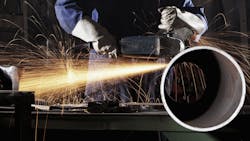April Sees Surge in Engineering and Construction Labor Costs Due to Higher Steel Prices
Engineering and construction costs increased again in April, according to the Engineering and Construction Cost Indicator from PEG and S&P Global Market Intelligence. The headline Engineering and Construction Cost Indicator, a leading indicator measuring wage and material inflation for the engineering, procurement and construction sector saw a solid increase to 77.7 this month. The sub-indicator for materials and equipment costs increased 8.3-points to 75.8 while the sub-indicator for subcontractor labor costs jumped to 82.4 in April from 68.5 in March.
Strong Increases in April
The materials and equipment indicator saw a strong increase in April. Ten of the 12 components increased compared to last month, and all of these ten had readings of at least 75.0 this month. The only two categories that declined were ocean freight from Asia and Europe to the USs, which declined 25.0- and 7.6-points respectively, leaving both in contractionary territory. Of the ten categories that increased, five of them saw increases of at least 15.0-points. Gas and steam turbines and transformers each increased by exactly 15.0 to 90.0 this month. Meanwhile, electrical equipment jumped 21.7-points and shell and tube heat exchangers saw the largest increase this month of 30.0-points. Fabricated structural steel saw the second largest increase of 27.3 points, but this resulted in a reading of 100.0 for April indicating that all respondents saw higher prices this month.
"It’s no surprise to see sweeping reports of higher fabricated structural steel pricing,” said Thomas McCartin, Principal Economist, S&P Global Market Intelligence. “The US’s policy change in March that removed country exemptions and product exclusions under Section 232 tariffs on steel, aluminum, and select fabricated metals has led to a quick jump in US pricing, in some cases in excess of the 25% tariff rate."
Subcontractor Labor Costs
The sub-indicator for current subcontractor labor costs also saw a significant increase, climbing to 82.4 after a reading of 68.5 last month. Increases were very widespread and all regions and employment categories are now at or above 75.0. Most readings saw increases of between 10.0- and 20.0-points this month, but some saw as high as 30.4-points. The only exceptions were instrumentation and electrical contractors in the US West which saw a minor 4.2-point decline to 83.3—the same reading as other subcontractors in the region—and mechanical subcontractors in Western Canada which were unchanged.
Looking Ahead
The six-month headline expectations for future construction costs indicator saw a solid decline to 74.1 in April. The six-month expectations indicator for materials and equipment came in at 76.9, 9.7-points lower than last month’s figure. All 12 categories saw declines, though most remain highly elevated with only three categories below 80.0 this month. Most declines were between 5.0- and 15.0-points, with fabricated structural steel seeing the only larger decline of 20.5-points. Ocean freight from Asia to the US saw a 9.1-points decline to a neutral reading of 50.0 this month, the only category not in expansionary territory.
Meanwhile, the six-month expectations indicator for sub-contractor labor also saw a solid decrease of 8.5-points this month. While the reading of 67.6 indicates a moderately tight pricing environment, this is far lower than the readings since the start of the year. Movements were varied, with ten subcontractor categories seeing declines, four increasing, and an additional four unchanged. The largest movements were a series of significant declines—25.0- to 50.0-points—registered in the US West, bringing all employment categories to neutral readings of 50.0.
Respondents report expected shortages for welders, electrical equipment components like switchgear and circuit breakers. Additional market comments suggested tariffs have played a large impact on pricing this month, and data centers are still the best market for construction.
To learn more about the Engineering and Construction Cost Indicator or to obtain the latest published insight, visit www.spglobal.com/market-intelligence.
This analysis was produced by S&P Global Market Intelligence, not S&P Global Ratings, which is a separately managed division of S&P Global.

